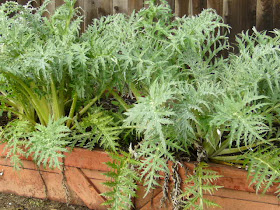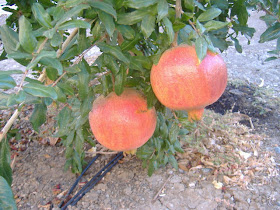 |
| Old Man Winter! |
A Happy Winter Solstice to you! As well as a Happy First Day of Winter. And why not throw in a Merry Christmas and Happy Holidays while I'm at it?
Ah -- the time you have when you're unemployed. I suppose I'd better enjoy it before the honeymoon ends. And it will end -- trust me.
It better!
This day is an important event for many gardeners. It's time to put 2010 behind us. It's the shortest day of the year (for certain parts of the world) -- and it also means that -- from this day forward -- we'll start to see more sunlight.
Those long days of summer are closer than you think.
So what exactly is the Winter Solstice? For that answer -- we turn to people who are much smarter than me (anyone and everyone). This fine bit of information is provided by www.timeanddate.com:
"The December solstice occurs when the sun reaches its most southerly declination of -23.5 degrees. In other words, it is when the North Pole is tilted 23.5 degrees away from the sun. Depending on the Gregorian calendar, the December solstice occurs annually on a day between December 20 and December 23. On this date, all places above a latitude of 66.5 degrees north are now in darkness, while locations below a latitude of 66.5 degrees south receive 24 hours of daylight.
...for an observer in the northern hemisphere, the December solstice marks the day of the year with the least hours of daylight for those living north of the Tropic of Cancer. Those living or traveling north of the Arctic Circle towards the North Pole will not be able to see the sun during this time of the year."
For gardening FANATICS like me and the wonderful Wife that is Venus? It means the official kickoff to planning next year's spring and summer gardens. It's a time to place an order for certain -- selected -- varieties of seed. It's time to drag out and piece together ye olde seed starting rack.
In other words? There's lots to do.
 |
| Pit River Bridge at Shasta Lake |
It's also a time to reflect. We've been incredibly fortunate so far this winter season in Northern California thanks to an early series of storms that have dropped a near-record amount of rainfall in the valley and boatloads of snow in the Sierra Nevada. Reservoirs that hold this bounty -- like the bathtub known as Lake Shasta -- are nearly full as the picture to the left indicates.
Water inflow is so strong at other storage facilities like Folsom Lake -- for example -- that dam operators are releasing record amounts of water into the American River below. River levels on the Sacramento -- American and Feather Rivers are at or near all-time highs.
 |
| Recently Transplanted Artichoke Plants |
The rainstorms we've received so far have been so strong and so furious that they've overwhelmed the drainage system in the front and backyards. I have a series of small lakes to prove it -- and water flow from that drainage system has been strong enough to blow off the plastic drain caps in the front yard.
Merry Freaking Christmas!
Despite all of that good news -- we're not out of the woods just yet. But we're off to a mighty fine start in the wet weather season.
Although I don't personally enjoy this time of year (who enjoys getting pelted with rain?) -- there is one plant in the Bird backyard that can not only "take it" -- it absolutely cries out for more.
You might remember that this was the state of my poor artichoke garden (pictured above) last month when I decided to transplant some new plants from one overcrowded bed to another that wasn't so crowded. How do artichoke plants react when they are dug up and planted somewhere else? They flop down like they're dead.
 |
| One Month Old Artichoke Transplants |
But they're not -- not really. This is the same bed about five weeks later. All of those plants that had FLOPPED have suddenly sprung back to life and are soaking up this cold and rainy weather. Artichokes do best in coastal weather conditions -- and we've had a lot of that in Northern California during the past couple of weeks -- with a lot more yet to come.
By this spring? It will be Artichoke City in the Backyard of Bird. And there is nothing quite like the nutty flavor of home-grown artichokes.
But -- don't worry -- all of those artichokes will find a good home. The phone just rang while I was typing this blog posting.
My days of "House Boy" for the Wife that is Venus are coming to an end. Unemployment is over. As of next week? It's back to the daily grind.
I hope the new boss likes home-grown artichokes and other home-grown goodies from our backyard. She has most certainly earned them.


















